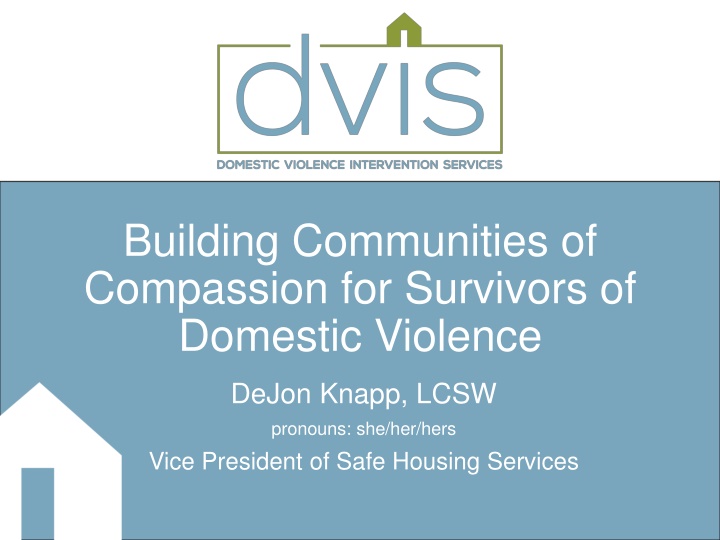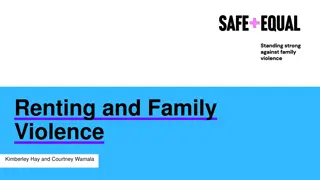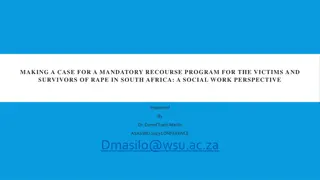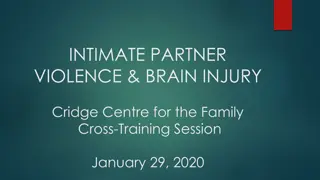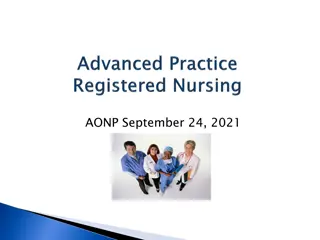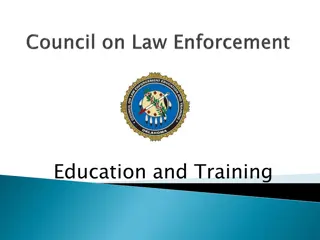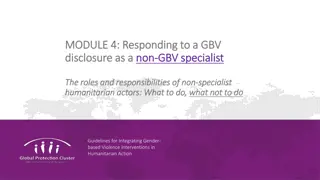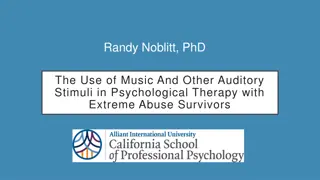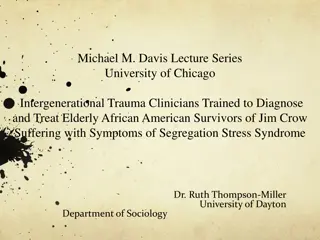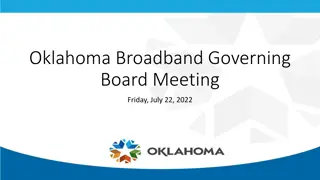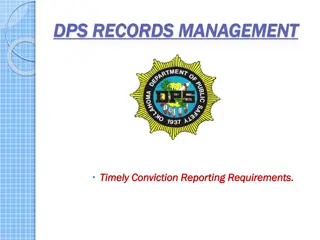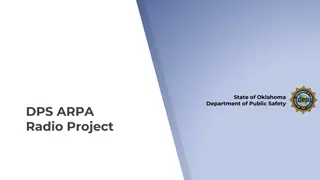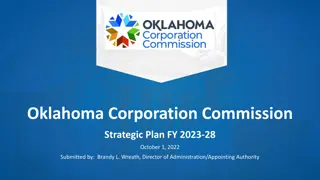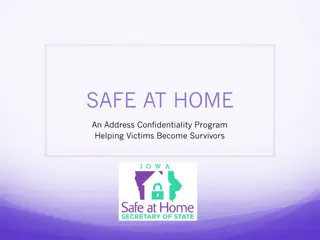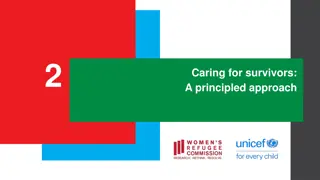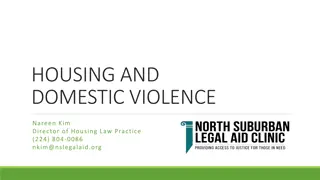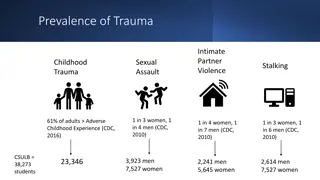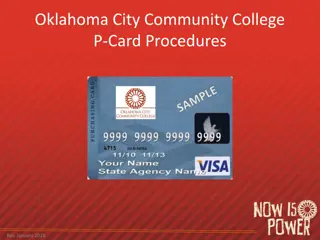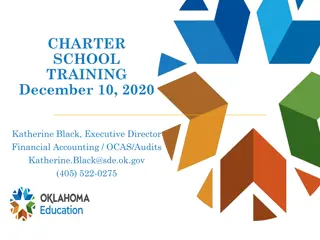Building Compassionate Communities for DV Survivors in Oklahoma
Challenges faced by survivors of domestic violence in Oklahoma. Explore biases, barriers, and trauma-informed responses. Learn about the unique issues affecting children and how to connect with communities of compassion.
Uploaded on Feb 27, 2025 | 3 Views
Download Presentation

Please find below an Image/Link to download the presentation.
The content on the website is provided AS IS for your information and personal use only. It may not be sold, licensed, or shared on other websites without obtaining consent from the author.If you encounter any issues during the download, it is possible that the publisher has removed the file from their server.
You are allowed to download the files provided on this website for personal or commercial use, subject to the condition that they are used lawfully. All files are the property of their respective owners.
The content on the website is provided AS IS for your information and personal use only. It may not be sold, licensed, or shared on other websites without obtaining consent from the author.
E N D
Presentation Transcript
Building Communities of Compassion for Survivors of Domestic Violence DeJon Knapp, LCSW pronouns: she/her/hers Vice President of Safe Housing Services
What We Will Discuss: In Context : Oklahoma Bias in working with survivors of violence Barriers for survivors Recognizing lethality indicators Trauma-informed responses to disclosures Special considerations for children Connection with one another! We are the communities of compassion! Q&A
What We Will Not Discuss: Confidential information Basic terms / definitions Violent experiences / war stories In depth research studies Clinical interventions to address trauma Complex safety planning Prevention of domestic violence
Emotional Emotional Acknowledgement Acknowledgement & & Limits of Limits of Confidentiality Confidentiality
Domestic Violence in Oklahoma Oklahoma is ranked 20th in United States for domestic violence. Oklahoma requires law enforcement to complete a LAP, Lethality Assessment Program, a multi- tiered response to prevent domestic violence homicide. Domestic Violence related crimes are considered "non- violent" in the state of Oklahoma. Recent growing conflict between DV Advocates and Justice Reform Advocates due to proposed policy changes in our state related to how DV crimes are classified/punished
Personal/Provider Bias Our own beliefs about what should be tolerated in relationships- "I would never let someone treat me like that." Our own beliefs about an ability to leave - "Why wouldn't you just leave?" Our own beliefs about violent partners- they are "all bad all the time" Our own beliefs about truthfulness- "They are so nice to everyone, this doesn t seem right" Gender bias- "But you are a man, how are you being abused?"
Why Can't They "Just" Leave? EMOTIONAL FINANCIAL PSYCHOLOGICAL CHILDREN PETS LACK OF ACCESS TO HELP /PERCEIVED LACK OF ACCESS TO HELP FEAR OF JUDGEMENT PREVIOUS IMMIGRATION STATUS/HISTORY OF INCARCERATION TARGETED IDENTITIES NEGATIVE EXPERIENCES WITH SYSTEMS
Lethality Indicators Used a weapon to cause harm or threats with a weapon? Threats to kill victim or their children? Does the victim think the person will try to kill them? Strangulation. Access to a firearm. Extreme jealousy, control, constant surveillance. Has the victim recently left perpetrator after living together or being married?
A moment to pause, breath, regulate
Taking Action- Domestic Violence Listen and be willing to hear difficult things. Listen more! Really listen! Actively listen! BELIEVE SURVIVORS! Express Support/Concern
Taking Action Continued Explore survivor s ideas of current needs and safety- ask questions! Offer to connect them to national, state, or local domestic violence agencies for safety planning and resources Mandated Reporting
Make sure the child knows it is not their fault. Kids have a right to feel and be safe, and adults have the responsibility of making that happen. Help children to identify their feelings and experience them, this includes painful emotions! Set healthy physical and emotional boundaries Help educate the parent on the impact of dv on children and coach them on how to talk about what has happened and what they are doing to keep kids safe. This is not a time for ignoring or making up stories. Supporting Children & Parent- Child Dyad
Help the parent to develop positive parenting skills and emotionally responsive caregiving habits to increase resiliency in child. Engage children in age appropriate safety planning if possible. Remember, letting kids know they are heard and cared for goes a long way! Supporting Children Continued
Self-Awareness/Your Experience Confidentiality Knowing your own triggers Knowing your own limits Think about your own emotional and physical safety when working with survivors. (hard to be helpful when you too are in crisis/unsafe)
Responding to DV/SA Responding to DV/SA Disclosures Disclosures Question the validity or truthfulness of disclosure- believe survivors when they disclose Asking questions that aren t relevant to the immediate safety or concerns of survivor Victim Blaming Tell them what to do (file a protective order, enter shelter, call police) Tell them you know exactly how they feel Tell them everything is going to be ok Engage in your own trauma disclosure Cry Ignore
References References Oklahoma Watch: Tensions between Victim Advocates and Justice Reform Supporters Oklahoma Watch: Domestic Violence Survivors in Oklahoma and Shallow Justice Oklahoma Attorney General: OK Domestic Violence Fatality Report Assessing Risk Factors for Intimate Partner Homicide Lethality Assessment Program- Maryland The Needs of Children in Domestic Violence Shelters
Additional Resources Additional Resources Low Impact Disclosure How to Help a Friend who is experiencing dv during COVID pandemic Seeking Help Online: Privacy & Safety Considerations National Network to End Domestic Violence National Coalition to End Domestic Violence Rape, Abuse & Incest National Network Strangulation Training Institute
DVIS 918.7HELP.ME (918.743.5763) 24 hours a day / 7 days a week dknapp@dvis.org 3124 E Apache Tulsa, OK 74110 918.743.5763 dvis.org @dvis
